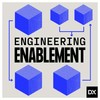

Engineering Enablement by DX
DX
The show focused on developer productivity and the teams and leaders dedicated to improving it. Each episode features in-depth interviews with Platform and DevEx teams, along with the latest research and approaches for measuring developer productivity. Presented by DX (getdx.com), the developer intelligence platform designed by researchers.
Episodes
Mentioned books

72 snips
May 21, 2024 • 40min
DORA, SPACE, and DevEx: Choosing the right framework | Laura Tacho + Abi Noda
CTO Laura Tacho and CEO Abi Noda discuss DORA, SPACE, and DevEx frameworks, their benefits, and challenges. They share insights on choosing the right framework, using DORA effectively, and practical applications in organizations.

14 snips
May 7, 2024 • 48min
The science behind DORA | Derek DeBellis (Google)
Derek Debellis, lead researcher on Google's DORA team, discusses the science behind DORA's research, including defining outcomes, survey design, model analysis, and survey development. He also talks about the nuances of literature review, benchmarks, and balancing data limitations with method sensitivity.

10 snips
Apr 23, 2024 • 34min
How Slack fully automates deploys and anomaly detection with Z-scores | Sean Mcllroy (Slack)
Sean Mcllroy from Slack's Release Engineering team discusses fully automating deploys and anomaly detection. Topics include the challenges of the deployment process, using Z-scores for anomaly detection, managing noise, automating deployments for efficiency, and handling large deployments to improve reliability.

24 snips
Apr 9, 2024 • 36min
What’s up with internal developer portals? | Chris Westerhold (Thoughtworks)
Thoughtworks Head of Developer Experience, Chris Westerhold, discusses the rising interest in developer portals, pitfalls to avoid, building vs. buying, driving value, and common mistakes. Explore the evolution of internal developer portals and strategies for optimizing success in this insightful conversation.

29 snips
Mar 26, 2024 • 45min
10 years of driving developer productivity at Yelp | Kent Wills (Yelp)
Kent Wills, Director of Engineering at Yelp, discusses the evolution of developer productivity efforts. Topics include forming the team, managing code ownership in a monolith, building a design system, standardization, LLM implementation, and demonstrating the value of their work.

9 snips
Mar 12, 2024 • 40min
How “instructional engineers” improve developer onboarding at Splunk | Gail Carmichael (Splunk)
Learn how instructional engineers at Splunk improve developer onboarding, measuring its success and impact. Gail Carmichael shares insights on the Engineering Enablement Team, components of a good onboarding program, and the importance of such programs. Discover the challenges and methods of measuring developer onboarding success, and the evolution of instructional engineering at Splunk.

17 snips
Feb 27, 2024 • 55min
Bootstrapping a developer portal | Adam Rogal (DoorDash)
Explore the journey of DoorDash's developer portal with Adam Rogal, from initial vision to driving adoption. Learn about funding, name selection, and valuable advice for beginners. Discover strategies for getting feedback, driving awareness, and what could have been done differently. Dive into practical leadership tips and the importance of developer tools for enhancing productivity.

12 snips
Feb 13, 2024 • 46min
A deep-dive on the Thoughtworks Tech Radar | Rebecca Parsons, Camilla Crispim, Erik Dörnenburg (Thoughtworks)
Rebecca Parsons, CTO at Thoughtworks, along with Camilla Crispim and Erik Dörnenburg, discuss the Thoughtworks Tech Radar. They cover its origins, impact on decision-making, and the philosophy behind it. They also talk about maintaining independence for their audience, the publication process, and recent changes. This episode offers an exclusive behind-the-scenes look at the history and production of Tech Radar.

22 snips
Jan 31, 2024 • 48min
Measuring and rolling out AI coding assistants | Eirini Kalliamvakou (GitHub)
Eirini Kalliamvakou, a staff researcher at GitHub, talks about how AI coding assistance impacts developer productivity. They discuss recent research on AI tools, key findings from the study, and how to advocate for AI tools. They also explore the implications of AI on measuring productivity and the impact of AI on developer experience.

21 snips
Jan 3, 2024 • 41min
Measuring developer productivity at Airbnb | Christopher Sanson (Airbnb)
Christopher Sanson, a product manager at Airbnb dedicated to enhancing developer productivity and tooling, discusses Airbnb's measurement journey, including their implementation of DORA metrics. He covers topics such as their approach before DORA metrics, planning the delivery of new metrics to the organization, and how Airbnb uses DORA metrics to review data and measure specific initiatives.


